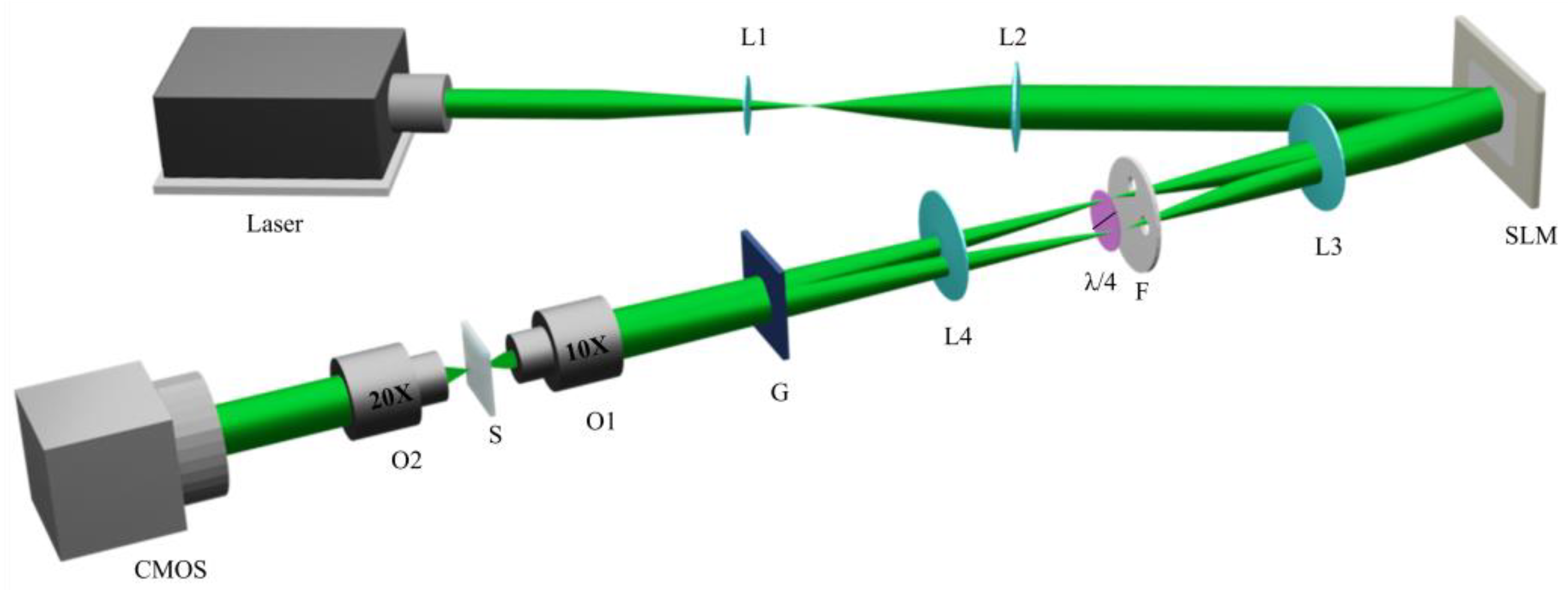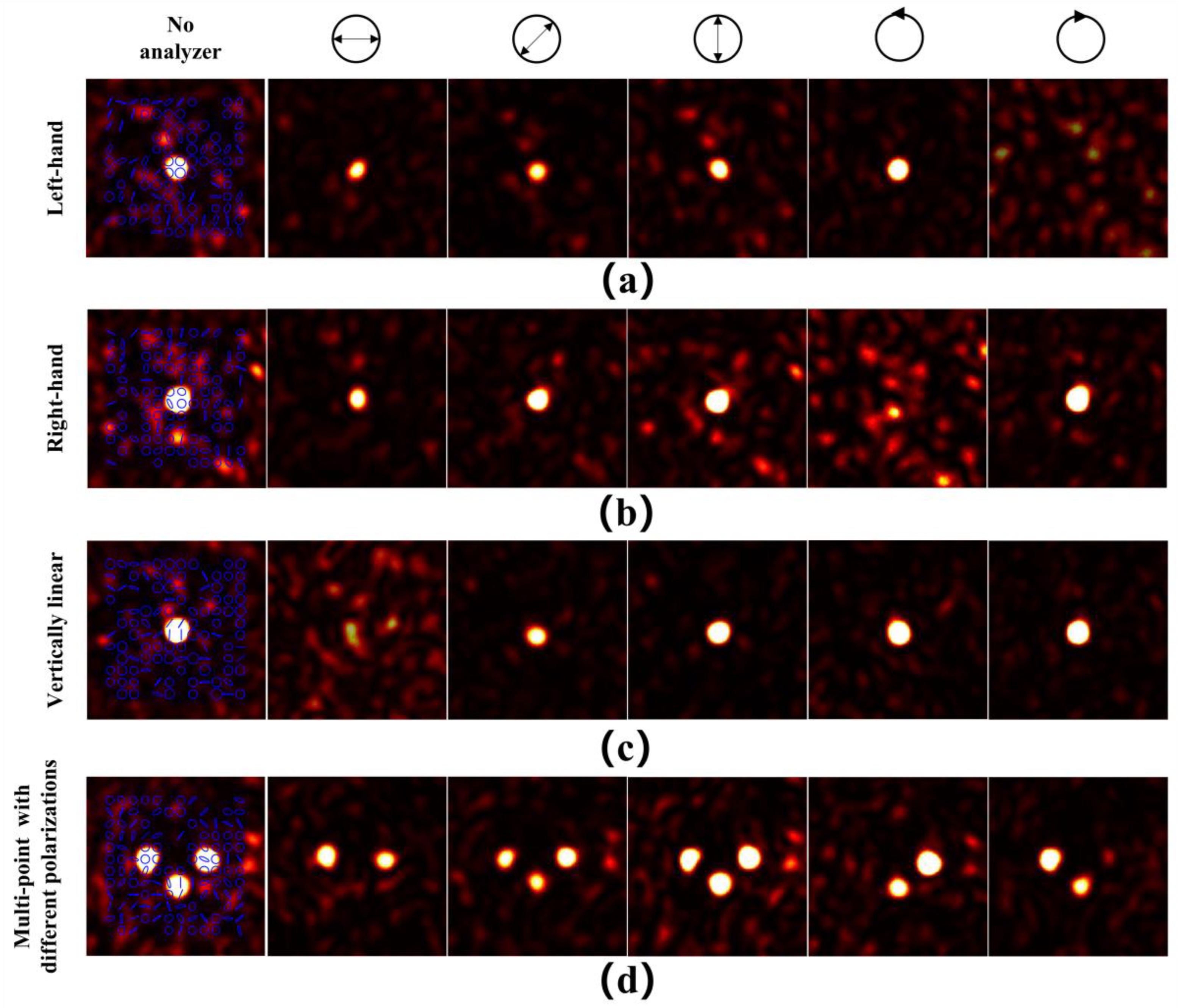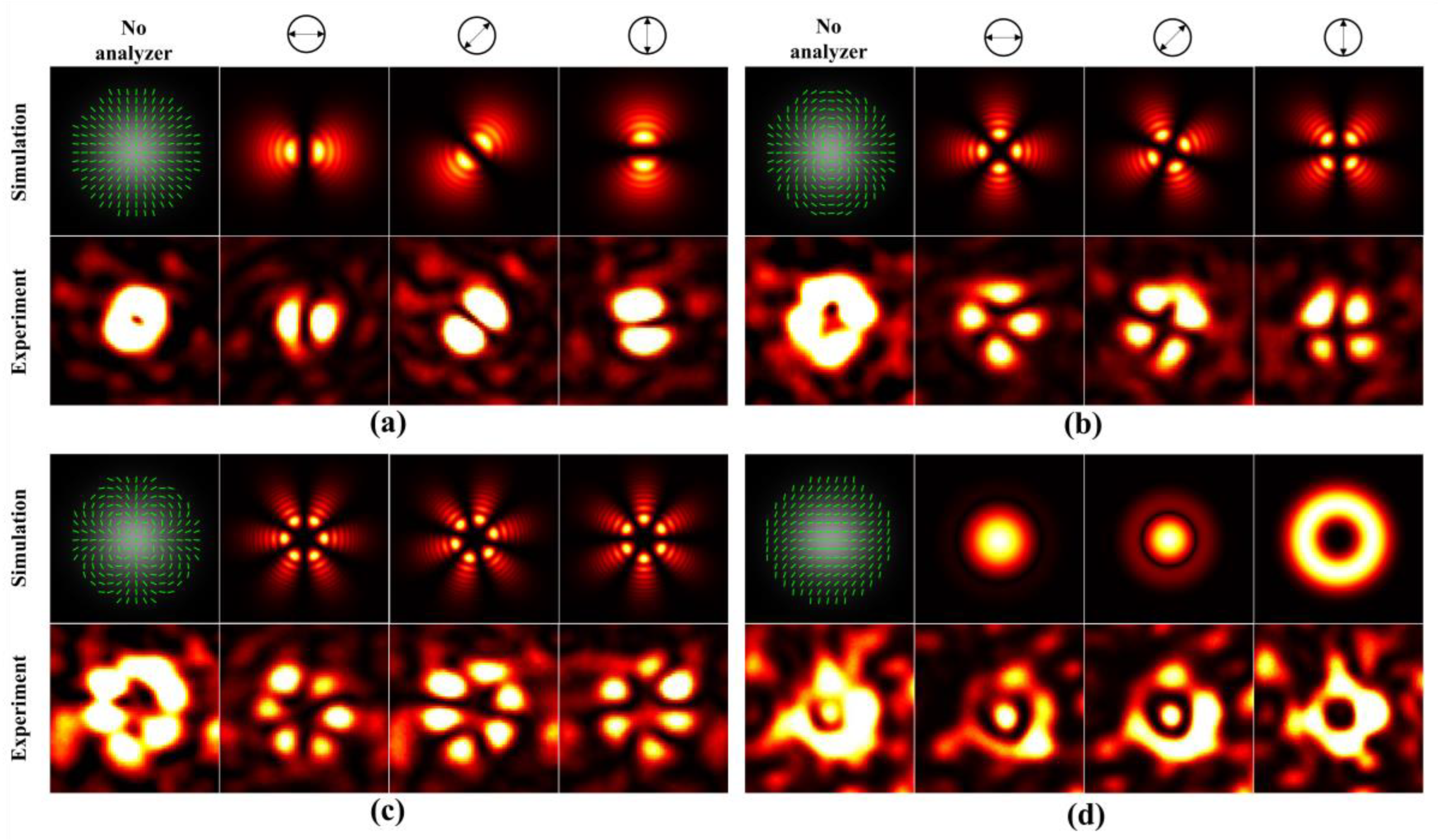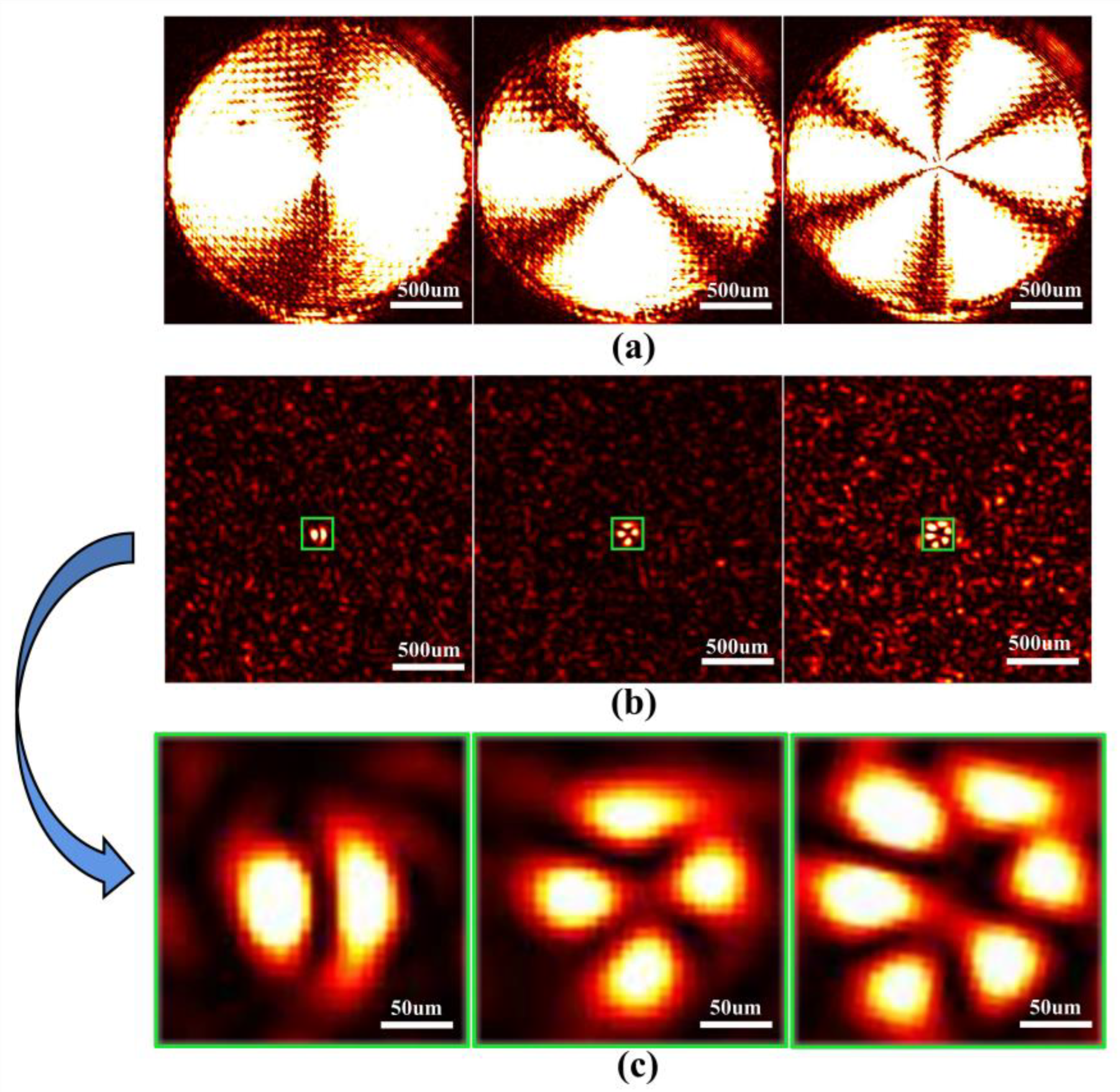Vectorial Manipulation of High-Resolution Focusing Optical Field through a Scattering Medium
Abstract
1. Introduction
2. Measurement of the Vector Transmission Matrix
3. Result Analysis
4. Discussion
5. Conclusions
Author Contributions
Funding
Institutional Review Board Statement
Informed Consent Statement
Data Availability Statement
Conflicts of Interest
References
- Pasquesi, J.J.; Schlachter, S.C.; Boppart, M.D.; Chaney, E.; Kaufman, S.J.; Boppart, S.A. In Vivo Detection of Exercise-Induced Ultrastructural Changes in Genetically-Altered Murine Skeletal Muscle Using Polarization-Sensitive Optical Coherence Tomography. Opt. Express 2006, 14, 1547–1556. [Google Scholar] [PubMed]
- Rao, R.A.R.; Mehta, M.R.; Toussaint, K.C. Fourier Transform-Second-Harmonic Generation Imaging of Biological Tissues. Opt. Express 2009, 17, 14534–14542. [Google Scholar] [CrossRef]
- Kotlyar, V.V.; Kovalev, A.A.; Zaitsev, V.D. Topological Charge of Light Fields with a Polarization Singularity. Photonics 2022, 9, 298. [Google Scholar] [CrossRef]
- Zaltron, A.; Merano, M.; Mistura, G.; Sada, C.; Seno, F. Optical Tweezers in Single-Molecule Experiments. Eur. Phys. J. Plus 2020, 135, 896. [Google Scholar] [CrossRef]
- Kozawa, Y.; Sato, S. Optical Trapping of Micrometer-Sized Dielectric Particles by Cylindrical Vector Beams. Opt. Express 2010, 18, 10828–10833. [Google Scholar] [CrossRef]
- Meier, M.; Romano, V.; Feurer, T. Material Processing with Pulsed Radially and Azimuthally Polarized Laser Radiation. Appl. Phys. A 2007, 86, 329–334. [Google Scholar] [CrossRef]
- Wang, H.; Shi, L.; Yuan, G.; Miao, X.; Tan, W.; Chong, T. Subwavelength and Super-Resolution Nondiffraction Beam. Appl. Phys. Lett. 2006, 89, 171102. [Google Scholar] [CrossRef]
- Zhang, X.; Xia, T.; Cheng, S.; Tao, S. Free-Space Information Transfer Using the Elliptic Vortex Beam with Fractional Topolog ical Charge. Opt. Commun. 2019, 431, 238–244. [Google Scholar] [CrossRef]
- Doronin, A.; Vera, N.; Staforelli, J.P.; Coelho, P.; Meglinski, I. Propagation of Cylindrical Vector Laser Beams in Turbid Tissue-Like Scattering Media. Photonics 2019, 6, 56. [Google Scholar] [CrossRef]
- Huang, H.; Chen, Z.; Sun, C.; Liu, J.; Pu, J. Light Focusing through Scattering Media by Particle Swarm Optimi zation. Chin. Phys. Lett. 2015, 32, 104202. [Google Scholar] [CrossRef]
- Popoff, S.M.; Lerosey, G.; Carminati, R.; Fink, M.; Boccara, A.C.; Gigan, S. Measuring the Transmission Matrix in Optics: An Approach to the Study and Control of Light Propagation in Disordered Media. Phys. Rev. Lett. 2010, 104, 100601. [Google Scholar] [CrossRef] [PubMed]
- Popoff, S.; Lerosey, G.; Fink, M.; Boccara, A.C.; Gigan, S. Controlling Light through Optical Disordered Media: Transmission Matrix Approach. New J. Phys. 2011, 13, 123021. [Google Scholar] [CrossRef]
- Conkey, D.B.; Caravaca-Aguirre, A.M.; Piestun, R. High-Speed Scattering Medium Characterization with Application to Fo cusing Light through Turbid Media. Opt. Express 2012, 20, 1733–1740. [Google Scholar] [CrossRef] [PubMed]
- Hofer, M.; Brasselet, S. Manipulating the Transmission Matrix of Scattering Media for Nonlinear Imaging beyond the Memory Effect. Opt. Lett. 2019, 44, 2137–2140. [Google Scholar] [CrossRef] [PubMed]
- Choi, Y.; Yang, T.D.; Fang-Yen, C.; Kang, P.; Lee, K.J.; Dasari, R.R.; Feld, M.S.; Choi, W. Overcoming the Diffraction Limit Using Multiple Light Scattering in a Highly Disordered Medium. Phys. Rev. Lett. 2011, 107, 023902. [Google Scholar] [CrossRef] [PubMed]
- Lee, K.; Park, Y. Exploiting the Speckle-Correlation Scattering Matrix for a Compact Reference-Free Holographic Image Sensor. Nat. Commun. 2016, 7, 13359. [Google Scholar] [CrossRef] [PubMed]
- Gong, C.; Shao, X.; Wu, T.; Liu, J.; Zhang, J. Total Variation Optimization for Imaging through Turbid Media with Transmission Matrix. Opt. Eng. 2016, 55, 121703. [Google Scholar] [CrossRef]
- Yang, H.; Huang, Y.; Gong, C.; Wu, T.; Shao, X. Advances on Techniques of Breaking Diffraction Limitation Using Scattering Medium. Chin. Opt. 2014, 7, 1–25. [Google Scholar]
- Liu, J.; Wang, J.; Li, W.; Sun, X.; Zhu, L.; Guo, C.; Shao, X. Programmable Multiwavelength Achromatic Focusing and Imaging through Scattering Media. IEEE Photonics J. 2018, 10, 6900811. [Google Scholar] [CrossRef]
- Cui, M.; Yang, C. Implementation of a Digital Optical Phase Conjugation System and Its Application to Study the Robustness of Turbidity Suppression by Phase Conjugation. Opt. Express 2010, 18, 3444–3455. [Google Scholar] [CrossRef]
- Lhermite, J.; Suran, E.; Kermène, V.; Louradour, F.; Desfarges-Berthelemot, A.; Barthélémy, A. Coherent Combining of 49 Laser Beams from a Multiple Core Optical Fiber by a Spatial Light Modulator. Opt. Express 2010, 18, 4783–4789. [Google Scholar] [CrossRef]
- Bertolotti, J.; Van Putten, E.G.; Blum, C.; Lagendijk, A.; Vos, W.L.; Mosk, A.P. Non-Invasive Imaging through Opaque Scatter ing Layers. Nature 2012, 491, 232–234. [Google Scholar] [CrossRef]
- Edrei, E.; Scarcelli, G. Optical Imaging through Dynamic Turbid Media Using the Fourier-Domain Shower-Curtain Effect. Optica 2016, 3, 71–74. [Google Scholar] [CrossRef]
- Wang, X.; Jin, X.; Li, J.; Lian, X.; Ji, X.; Dai, Q. Prior-Information-Free Single-Shot Scattering Imaging beyond the Memory Effect. Opt. Lett. 2019, 44, 1423–1426. [Google Scholar] [CrossRef] [PubMed]
- Vellekoop, I.M.; Lagendijk, A.; Mosk, A. Exploiting Disorder for Perfect Focusing. Nat. Photonics 2010, 4, 320–322. [Google Scholar] [CrossRef]
- Choi, Y.; Hillman, T.R.; Choi, W.; Lue, N.; Dasari, R.R.; So, P.T.; Choi, W.; Yaqoob, Z. Measurement of the Time-Resolved Reflection Matrix for Enhancing Light Energy Delivery into a Scattering Medium. Phys. Rev. Lett. 2013, 111, 243901. [Google Scholar] [CrossRef] [PubMed]
- Tripathi, S.; Paxman, R.; Bifano, T.; Toussaint, K.C. Vector Transmission Matrix for the Polarization Behavior of Light Propa gation in Highly Scattering Media. Opt. Express 2012, 20, 16067–16076. [Google Scholar] [CrossRef] [PubMed]
- Xie, Y.-Y.; Wang, B.-Y.; Cheng, Z.-J.; Yue, Q.-Y.; Guo, C.-S. Measurement of Vector Transmission Matrix and Control of Beam Focusing through a Multiple-Scattering Medium Based on a Vector Spatial Light Modulator and Two-Channel Polarization Holography. Appl. Phys. Lett. 2017, 110, 221105. [Google Scholar] [CrossRef]
- Yu, P.; Zhao, Q.; Hu, X.; Li, Y.; Gong, L. Tailoring Arbitrary Polarization States of Light through Scattering Media. Appl. Phys. Lett. 2018, 113, 121102. [Google Scholar] [CrossRef]
- Zhao, Q.; Tu, S.; Lei, Q.; Guo, C.; Zhan, Q.; Cai, Y. Creation of Cylindrical Vector Beams through Highly Anisotropic Scattering Media with a Single Scalar Transmission Matrix Calibration. Photonics Res. 2022, 10, 1617–1623. [Google Scholar] [CrossRef]
- MacKintosh, F.C.; Zhu, J.-X.; Pine, D.; Weitz, D. Polarization Memory of Multiply Scattered Light. Phys. Rev. B 1989, 40, 9342. [Google Scholar] [CrossRef] [PubMed]
- Shumyatsky, P.; Milione, G.; Alfano, R.R. Optical Memory Effect from Polarized Laguerre–Gaussian Light Beam in Light-Scattering Turbid Media. Opt. Commun. 2014, 321, 116–123. [Google Scholar] [CrossRef]
- Liu, C.; Zhu, H.; Chen, R.-P.; Dai, C.-Q.; He, S. Polarization Evolution of a Vector Vortex Optical Field in a Strongly Nonlocal Nonlinear Medium. IEEE Photonics J. 2019, 11, 6101210. [Google Scholar] [CrossRef]
- Xie, Y.-Y. Study on Wavefront Control and Application of Vector Beams. Ph.D. Thesis, Shandong Normal University, Jinan, China, 2017. [Google Scholar]
- Stary, M.; Novotny, F.; Horak, M.; Stara, M.; Hotar, V.; Matusek, O. Summary of the Properties and Benefits of Glass Mechanically Frosted with an Abrasive Brush. Constr. Build. Mater. 2019, 206, 364–374. [Google Scholar] [CrossRef]
- Chen, R.-P.; Chen, Z.; Chew, K.-H.; Li, P.-G.; Yu, Z.; Ding, J.; He, S. Structured Caustic Vector Vortex Optical Field: Manipu lating Optical Angular Momentum Flux and Polarization Rotation. Sci. Rep. 2015, 5, 10628. [Google Scholar] [CrossRef] [PubMed]
- Chen, H.; Hao, J.; Zhang, B.-F.; Xu, J.; Ding, J.; Wang, H.-T. Generation of Vector Beam with Space-Variant Distribution of Both Polarization and Phase. Opt. Lett. 2011, 36, 3179–3181. [Google Scholar] [CrossRef]
- Van Putten, E.G.; Akbulut, D.; Bertolotti, J.; Vos, W.L.; Lagendijk, A.; Mosk, A. Scattering Lens Resolves Sub-100 Nm Structures with Visible Light. Phys. Rev. Lett. 2011, 106, 193905. [Google Scholar] [CrossRef] [PubMed]
- Galaktionov, I.; Nikitin, A.; Sheldakova, J.; Toporovsky, V.; Kudryashov, A. Focusing of a Laser Beam Passed through a Mod erately Scattering Medium Using Phase-Only Spatial Light Modulator. Photonics 2022, 9, 296. [Google Scholar] [CrossRef]
- Zheng, S.; Yang, W.; Situ, G. Application of Computational Optical Imaging in Scattering. Infrared Laser Eng. 2019, 48, 603005. [Google Scholar] [CrossRef]
- Sun, C.; Zhao, Y.; An, Z.; Fu, Q.; Zhan, J.; Duan, J. Effect of Concentration on Propagation Characteristics of Polarized Laser in Oil-Mist Diffusion. J. Appl. Opt. 2017, 38, 6. [Google Scholar]






Publisher’s Note: MDPI stays neutral with regard to jurisdictional claims in published maps and institutional affiliations. |
© 2022 by the authors. Licensee MDPI, Basel, Switzerland. This article is an open access article distributed under the terms and conditions of the Creative Commons Attribution (CC BY) license (https://creativecommons.org/licenses/by/4.0/).
Share and Cite
Qi, B.; Shen, L.; Chew, K.-H.; Chen, R.-P. Vectorial Manipulation of High-Resolution Focusing Optical Field through a Scattering Medium. Photonics 2022, 9, 737. https://doi.org/10.3390/photonics9100737
Qi B, Shen L, Chew K-H, Chen R-P. Vectorial Manipulation of High-Resolution Focusing Optical Field through a Scattering Medium. Photonics. 2022; 9(10):737. https://doi.org/10.3390/photonics9100737
Chicago/Turabian StyleQi, Bote, Lihua Shen, Khian-Hooi Chew, and Rui-Pin Chen. 2022. "Vectorial Manipulation of High-Resolution Focusing Optical Field through a Scattering Medium" Photonics 9, no. 10: 737. https://doi.org/10.3390/photonics9100737
APA StyleQi, B., Shen, L., Chew, K.-H., & Chen, R.-P. (2022). Vectorial Manipulation of High-Resolution Focusing Optical Field through a Scattering Medium. Photonics, 9(10), 737. https://doi.org/10.3390/photonics9100737





